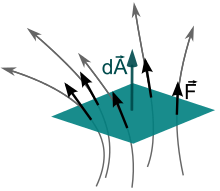Flow (physics)
Different physical quantities are referred to as flow , which result as the product of a field and an area. The usual symbol for these quantities is (capital phi).
Possible flow sizes
Let the flux density be a scalar field or a vector field and the area under consideration (the area multiplied by the normal unit vector of the area). Then three flow quantities can be formed:
Scalar flow of a vector field:
Vector flow of a scalar field:
Vector flow of a vector field:
Scalar flow of a vector field
The scalar flow of a vector field, the scalar product of the vector field and area, is particularly important in practice . Although this flow is a scalar quantity, it is sometimes called a vector flow in the literature . If the vector field - also known as the flux density - is constant over the area , the integral simply changes into the scalar product:
- .
Important scalar flows of vector fields are, for example, the volume flow , the magnetic flow and the electrical flow .
Magnetic flux surfaces play a role in the plasma physics of fusion reactors (see rotational transformation ). A flow surface is characterized by the fact that the flow through each of its surface elements is zero. So the vectors are parallel to it. Often nested river areas are considered, which, starting from the greatest flow density, envelop an ever larger part of the river.
See also
- Continuity equation , concerns a special property of rivers, which are assigned to a conservation quantity
- Electric current density , an example of a vector field
Web links
Individual evidence
- ^ Brockhaus Science and Technology . Volume 3. Spektrum Verlag, 2003, ISBN 3-7653-1063-8 , p. 2082.









